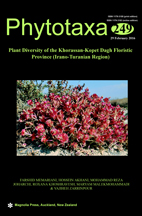Abstract
Ghorkhod Protected Area (GPA) is located in a transitional zone among different biogeographical units in North Khorassan Province, NE Iran. The study area is mainly a mountainous region in western extensions of Khorassan-Kopet Dagh floristic province. We investigated the floristic composition, life form spectrum and phytogeography of the study area through several random collection efforts and 200 vegetation samples (reléves) in selected vegetation types during 2007–2012. A total of 663 vascular plant species belonging to 367 genera and 81 families are recorded as native and naturalized in GPA. Angiosperms and Dicots are among the most diverse plant groups. The richest plant families are Asteraceae (88 species), Poaceae (78), Lamiaceae (45), Brassicaceae (43), Fabaceae (38), and Caryophyllaceae (32). The genera Allium L. (17 species), Astragalus L. (15) and Cousinia Cass. (12) are the richest ones, however, the majority of the species belongs to oligotypic and monotypic genera. Life form spectrum of the study area is dominated by hemicryptophytes (38.9%) and therophytes (23.4%). Allium transvestiens Vved., Agropyron desertorum Schult., Helictotrichon turcomanicum Czopanov and Piptatherum latifolium (Roshev.) Nevski are recorded as new to Iran. The core flora of the area has the Irano-Turanian origin. However, the wide-range and widespread elements are also well represented in the study area. GPA is inhabited by several endemic, rare and narrow-range plant species, indicating the biodiversity importance of the study area in NE Iran.

